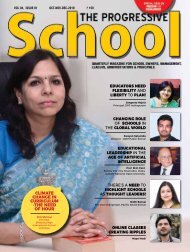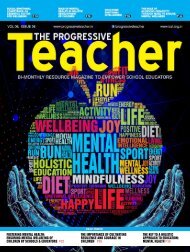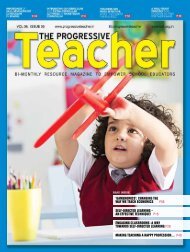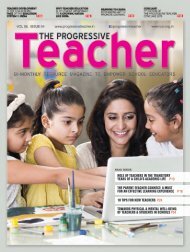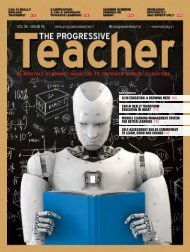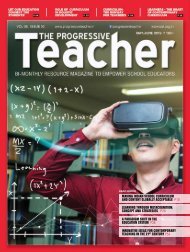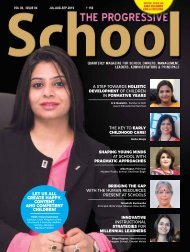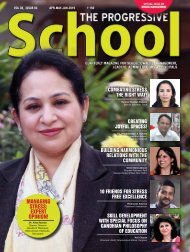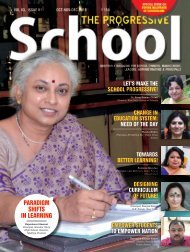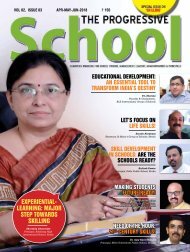The Progressive Teacher Vol 02 Issue 04
This issue of The Progressive Teacher focuses on "Teaching- Emotional Fulfillment and Self-Actualisation". The magazine provides guidance to the teachers by their peers and school leaders for tackling challenges with innovative ideas. Happy Reading!
This issue of The Progressive Teacher focuses on "Teaching- Emotional Fulfillment and Self-Actualisation". The magazine provides guidance to the teachers by their peers and school leaders for tackling challenges with innovative ideas. Happy Reading!
Create successful ePaper yourself
Turn your PDF publications into a flip-book with our unique Google optimized e-Paper software.
counselling<br />
ask sarita<br />
Sarita Mathur is a free-lance education consultant offering services to schools, both rural and urban,<br />
in India and abroad. An alumnus of St. Stephen’s College, Sarita has a degree in Mathematics,<br />
Education and a post-graduate degree in Operations Research. <strong>The</strong> Mathematics background and her<br />
well-honed sense of systems and processes had her institutionalise several long lasting and important<br />
changes as Principal of <strong>The</strong> Shri Ram School placing it firmly on the map as a progressive and leading<br />
school of India. Sarita has served as a consultant on the International curriculum of the CBSE and also<br />
serves as advisor/consultant to several curriculum companies, schools and start-up ventures.<br />
Q: What is a rubric? I understand it helps a teacher to mark<br />
student work. Can you elaborate?<br />
Ans: A rubric is a tool that is used to assess student work. In a rubric,<br />
work is assessed on fixed and pre-decided criteria. <strong>The</strong>se criteria can<br />
be decided on by the teacher who will be conducting the assessment.<br />
A student is graded on each criterion as per a 5 to 1 scale (5 highest,<br />
1 lowest). How a student gets a particular score is described in crisp,<br />
descriptive detail e.g. what exactly is expected of a student in order<br />
that she gets a 5 on the first parameter? Descriptions are given for the<br />
other scores as well i.e. 4, 3 , 2 and 1. <strong>The</strong>se descriptions are called<br />
‘descriptors’.<br />
<strong>The</strong> descriptors are valuable to the student and teacher alike. <strong>The</strong>y tell<br />
the student what they have to do or what their work should reflect<br />
and/or display in order that they produce high quality work and hence<br />
score the maximum marks possible on that criterion. At the same time<br />
they tell the teacher what to look for and how to award marks in a<br />
transparent and fair way across all students thereby encouraging and<br />
obtaining high quality work among students.<br />
Here is an example of a rubric that has been designed for assessing<br />
‘hand writing development’ in Class 2 students. <strong>The</strong> teacher has<br />
chosen four criteria on which to assess handwriting namely: formation<br />
of letters, spacing of letters, slant of letters and neatness. Note, the<br />
teacher is using a three–point scale and not a five-point one to decide<br />
the level of attainment on each criterion.<br />
Criteria<br />
Formation<br />
of letters<br />
Spacing of<br />
letters<br />
Slant of<br />
letters<br />
Neatness<br />
Tops and<br />
bottoms of<br />
various letters<br />
are well<br />
aligned, loops<br />
perfect, letterformation<br />
accurate<br />
Perfectly even<br />
Perfectly even<br />
Descriptors<br />
3 2<br />
No visible<br />
erasing, uses<br />
pointed pencil,<br />
no smudges<br />
Most but not<br />
all letters<br />
are aligned,<br />
loops mostly<br />
well formed,<br />
most letters<br />
are formed<br />
correctly<br />
Somewhat<br />
even<br />
More or less<br />
even<br />
Some erasing,<br />
overall quite<br />
neat but<br />
not quite<br />
spectacular<br />
1<br />
Tops and<br />
bottoms of<br />
letters mostly<br />
not aligned,<br />
formation of<br />
letters sloppy<br />
and irregular<br />
Irregular with<br />
uneven sized<br />
gaps<br />
Uneven, sloping<br />
in different<br />
ways<br />
Messy, work<br />
does not have a<br />
pleasant look;<br />
use of blunt<br />
pencil, smudges<br />
visible.<br />
Many teachers mistake a rubric for a marking guide or marking<br />
scheme. Marking guides are not so specific and descriptive as rubrics.<br />
Rubrics are best used for project work, activities or to assess progress<br />
of students on development of certain skills over a period of time e.g.<br />
essay writing. Marking guides are mostly used for marking tests!<br />
Q: What is the difference between ‘drill’ and ‘practice’?<br />
Ans: Drill is specific type of practice.<br />
When<br />
a student<br />
practices a<br />
certain type of task<br />
with some but deliberately<br />
very little variation for an<br />
extended period of time, it is a ‘drill’.<br />
Drills are usually used to consolidate skills<br />
that have already been acquired. Drills can get<br />
progressively tougher.<br />
‘Practice’ involves performing tasks both repeatedly and regularly<br />
in order to acquire, improve and remain proficient. <strong>The</strong> benefits of<br />
practice are usually more enduring in nature as compared to the<br />
benefit of drills. However drills are useful as they comprise parts that<br />
make the whole.<br />
A basketball player is being drilled as his coach asks him to repeatedly<br />
do layups with variations in perhaps - line of approach. <strong>The</strong> player is<br />
practising the skill that he has acquired through drill (taking layups)<br />
by taking passes, being obstructed as he approaches the basket and<br />
shooting.<br />
<strong>The</strong> simplified examples below highlight the difference.<br />
Practice Task<br />
Expand the following:<br />
1. (a + 5)2<br />
2. (3 – b)2<br />
3. (5x+ 2)2<br />
4. (y – 8)2<br />
5. (2x – 2y)2<br />
6. (a + 5)3<br />
Drill Task<br />
Expand the following:<br />
1. (a + b)2<br />
2. (a + x)2<br />
3. (x + 2)2<br />
4. (2 + b)2<br />
5. (2x + w)2<br />
6. (x + 2w)2<br />
Q: What should I do to teach my senior students to say ‘good<br />
morning’ to me (or their other teachers) when they cross me in<br />
the corridor? <strong>The</strong>y just walk by as if they have not seen me. I feel<br />
it is disrespectful.<br />
Ans: You are right. Most societies do expect individuals to<br />
acknowledge one another’s presence, especially when they are known<br />
to each other with a greeting, smile or body gesture. It is civil and an<br />
accepted norm. If your students are not wishing you, use a strategy<br />
that will work overnight. Don’t wait for them to walk past you, wish<br />
them instead with a loud cheerful ‘good morning’ taking their name as<br />
you greet.<br />
Try it today. Don’t forget to smile!<br />
Email your queries at:<br />
asksarita@progressiveteacher.in<br />
8 <strong>The</strong> <strong>Progressive</strong> <strong>Teacher</strong> Sep/Oct 2015





